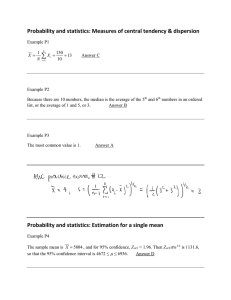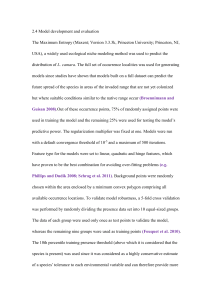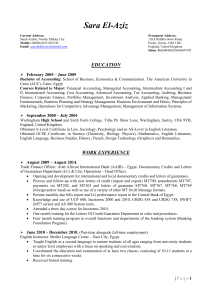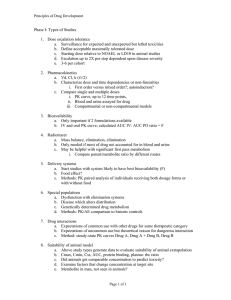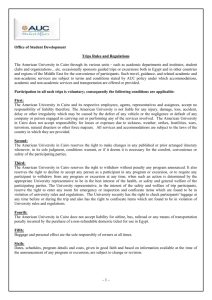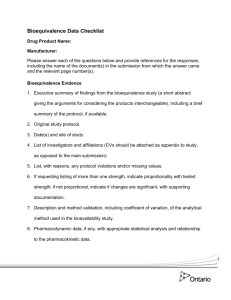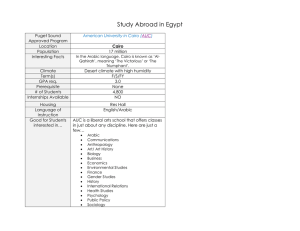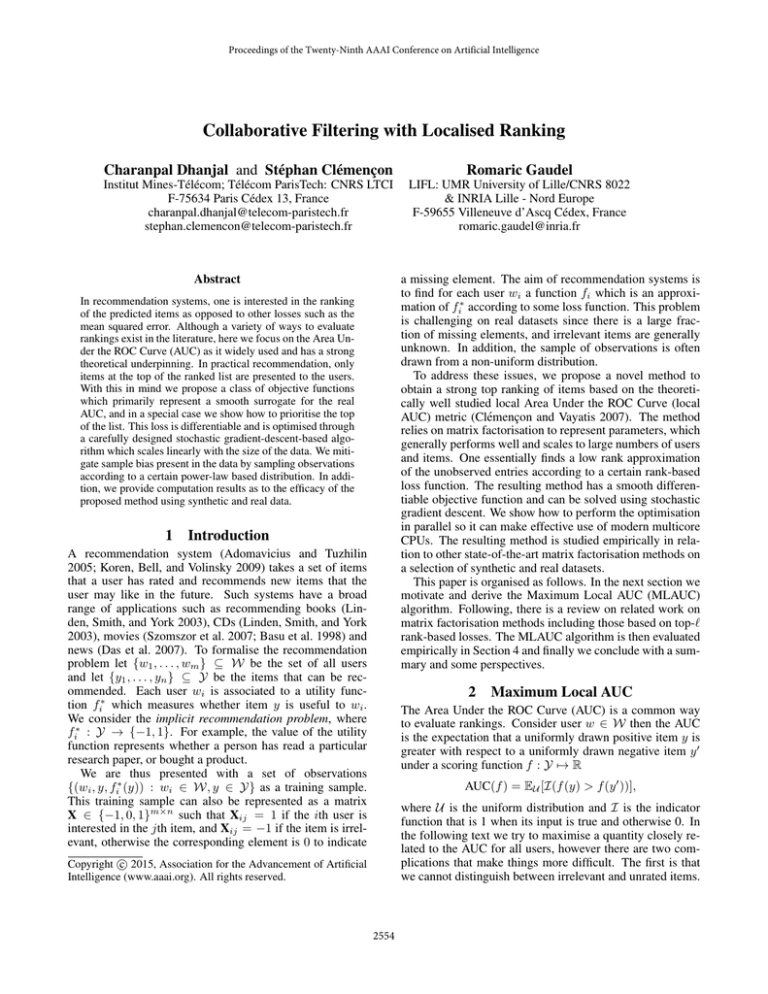
Proceedings of the Twenty-Ninth AAAI Conference on Artificial Intelligence
Collaborative Filtering with Localised Ranking
Charanpal Dhanjal and Stéphan Clémençon
Romaric Gaudel
Institut Mines-Télécom; Télécom ParisTech: CNRS LTCI
F-75634 Paris Cédex 13, France
charanpal.dhanjal@telecom-paristech.fr
stephan.clemencon@telecom-paristech.fr
LIFL: UMR University of Lille/CNRS 8022
& INRIA Lille - Nord Europe
F-59655 Villeneuve d’Ascq Cédex, France
romaric.gaudel@inria.fr
Abstract
a missing element. The aim of recommendation systems is
to find for each user wi a function fi which is an approximation of fi∗ according to some loss function. This problem
is challenging on real datasets since there is a large fraction of missing elements, and irrelevant items are generally
unknown. In addition, the sample of observations is often
drawn from a non-uniform distribution.
To address these issues, we propose a novel method to
obtain a strong top ranking of items based on the theoretically well studied local Area Under the ROC Curve (local
AUC) metric (Clémençon and Vayatis 2007). The method
relies on matrix factorisation to represent parameters, which
generally performs well and scales to large numbers of users
and items. One essentially finds a low rank approximation
of the unobserved entries according to a certain rank-based
loss function. The resulting method has a smooth differentiable objective function and can be solved using stochastic
gradient descent. We show how to perform the optimisation
in parallel so it can make effective use of modern multicore
CPUs. The resulting method is studied empirically in relation to other state-of-the-art matrix factorisation methods on
a selection of synthetic and real datasets.
This paper is organised as follows. In the next section we
motivate and derive the Maximum Local AUC (MLAUC)
algorithm. Following, there is a review on related work on
matrix factorisation methods including those based on top-`
rank-based losses. The MLAUC algorithm is then evaluated
empirically in Section 4 and finally we conclude with a summary and some perspectives.
In recommendation systems, one is interested in the ranking
of the predicted items as opposed to other losses such as the
mean squared error. Although a variety of ways to evaluate
rankings exist in the literature, here we focus on the Area Under the ROC Curve (AUC) as it widely used and has a strong
theoretical underpinning. In practical recommendation, only
items at the top of the ranked list are presented to the users.
With this in mind we propose a class of objective functions
which primarily represent a smooth surrogate for the real
AUC, and in a special case we show how to prioritise the top
of the list. This loss is differentiable and is optimised through
a carefully designed stochastic gradient-descent-based algorithm which scales linearly with the size of the data. We mitigate sample bias present in the data by sampling observations
according to a certain power-law based distribution. In addition, we provide computation results as to the efficacy of the
proposed method using synthetic and real data.
1
Introduction
A recommendation system (Adomavicius and Tuzhilin
2005; Koren, Bell, and Volinsky 2009) takes a set of items
that a user has rated and recommends new items that the
user may like in the future. Such systems have a broad
range of applications such as recommending books (Linden, Smith, and York 2003), CDs (Linden, Smith, and York
2003), movies (Szomszor et al. 2007; Basu et al. 1998) and
news (Das et al. 2007). To formalise the recommendation
problem let {w1 , . . . , wm } ⊆ W be the set of all users
and let {y1 , . . . , yn } ⊆ Y be the items that can be recommended. Each user wi is associated to a utility function fi∗ which measures whether item y is useful to wi .
We consider the implicit recommendation problem, where
fi∗ : Y → {−1, 1}. For example, the value of the utility
function represents whether a person has read a particular
research paper, or bought a product.
We are thus presented with a set of observations
{(wi , y, fi∗ (y)) : wi ∈ W, y ∈ Y} as a training sample.
This training sample can also be represented as a matrix
X ∈ {−1, 0, 1}m×n such that Xij = 1 if the ith user is
interested in the jth item, and Xij = −1 if the item is irrelevant, otherwise the corresponding element is 0 to indicate
2
Maximum Local AUC
The Area Under the ROC Curve (AUC) is a common way
to evaluate rankings. Consider user w ∈ W then the AUC
is the expectation that a uniformly drawn positive item y is
greater with respect to a uniformly drawn negative item y 0
under a scoring function f : Y 7→ R
AUC(f ) = EU [I(f (y) > f (y 0 ))],
where U is the uniform distribution and I is the indicator
function that is 1 when its input is true and otherwise 0. In
the following text we try to maximise a quantity closely related to the AUC for all users, however there are two complications that make things more difficult. The first is that
we cannot distinguish between irrelevant and unrated items.
c 2015, Association for the Advancement of Artificial
Copyright Intelligence (www.aaai.org). All rights reserved.
2554
for a user-defined regularisation parameter λ, hinge loss
h(x) = max(0, 1 − x), rank weighting function φ, item
difference γi,p,q = uTi vp − uTi vq and independent item distributions g and g 0 . The first sum in the first term averages
over users and the second sum computes ranking losses over
positive items ωi . The second
Pterm is a penalisation on the
Frobenius norms (kAk2F = ij A2ij )) of the user and item
factor matrices. Concrete item distributions g and g 0 are discussed later in this section.
Consider the weighting function φ(x) = x, then after
some rearrangement, one can see that the first term in the
objective follows directly from AUC (Equation 1), replacing the indicator function with the squared hinge loss. The
optimisation in this case is convex in U and V but not both simultaneously. This form of the objective however, does not
take into account the preference for ranking items correctly
at the top of the list. Consider instead φ(x) = tanh(x) for
x ≥ 0, which is a concave function. The term inside φ in
Optimisation 2 represents a ranking loss for ith user and pth
item and thus yp is high up in the ranked list if this quantity is small. The effect of choosing the hyperbolic tangent
is that items with small losses have larger gradients towards
the optimal solution and hence are prioritised.
A second challenge is that the number of ratings per item is
non-uniform and hence we cannot easily compute the AUC
as given above.
A common way to address the first challenge is simply
to consider the missing elements as negative (Cremonesi,
Koren, and Turrin 2010; Steck 2010). The second issue
is more challenging, and sampling uniformly from the the
data implies an expectation above with respect to some nonuniform distribution p0 . In the recommendation case redefine X ∈ {0, 1}m×n as the matrix of users and their relevant
items where +1 signifies relevant items and 0 is an irrelevant
or missing item. Consider a user w and a rating function f ,
then the empirical AUC for this user is:
[ )=
AUC(f
XX
I(f (yp ) > f (yq ))g(yp )g 0 (yq ),
(1)
p∈ω q∈ω̄
where ω is the set of indices of relevant items for user w,
ω̄ is the complement of ω, and g, g 0 are distributions on the
relevant and irrelevant items respectively. The most intuitive
choices for g and g 0 are the uniform distributions. On real
datasets however, item ratings often have a long tail distribution so that a small number of items represent large proportions of the total number of ratings. This opens up the
question as to whether the so-called popularity bias might be
an advantage to recommender systems that predict using the
same distribution, however accuracy experienced by users is
closely related to performance on complete data rather than
available data, see (Steck 2010).
The AUC certainly captures a great deal of information
about the ranking of items for each user, however as pointed
out by previous authors, in practice one is only interested in
the top items in that ranking. Two scoring functions f and
f 0 could have identical AUC scores and yet f for example
scores badly on the top few items but recovers lower down
the list. One way of measuring this behaviour is through
local AUC which measures the expectation that a positive
item is scored higher than a negative one, and the positive
one is in the top tth quantile. This is equivalent to saying
that we ignore positive items low down in the ranking.
2.1
2.2
Optimisation
Using this latter definition of φ, the gradients with respect to
the objective θ are computed as
!
X
δθ
1 X
=
g(yp )
(vq − vp )h(γi,p,q )g 0 (yq )
δui
m p∈ω
q∈ω̄
i
i
!!
X
λ
2
2 0
1 − tanh
h(γi,p,q ) g (yq )
+ ui ,
m
q∈ω̄
i
and the corresponding gradient with respect to vj is
m
δθ
1 X
ui
=
δvj
m i=1
Ij∈ω̄i g 0 (yj )
X
g(yp )h(γi,p,j ) ·
p∈ωi
!!
2
1 − tanh
Surrogate Objective
X
2 0
h(γi,p,q ) g (yq )
q∈ω̄i
Clearly the direct maximisation of AUC is not practical,
since it is non-smooth and non-differentiable and hence we
use the squared hinge loss to approximate the indicator function. First we define model scores for the ith user and jth
item as (UVT )ij in which U ∈ Rm×k and V ∈ Rn×k are
user and item factors, and we will refer to the ith row of U
and V as ui and vi respectively. The advantage of this strategy is that the scoring functions have k(m + n) parameters
and hence scale linearly with both the number of users and
items. We thus propose solving the following optimisation
(with penalties motivated by the data dependant bounds in
(Usunier, Amini, and Gallinari 2005)):
!
m
X
1 XX
min
g(yp )φ
h(γi,p,q )2 g 0 (yq )
2m i=1 p∈ω
q∈ω̄i
i
(2)
λ
+
(kUk2F + kVk2F ),
2m
− Ij∈ωi g(yj )
X
g 0 (yq )h(γi,j,q )·
q∈ω̄i
!!!
2
1 − tanh
X
`∈ω̄i
2 0
h(γi,j,` ) g (y` )
+
λV
vj .
m
It is worth noting that the contribution
to the derivatives
2 P
2 0
of tanh lies in the 1 − tanh
q∈ω̄i h(γi,p,q ) g (yq )
terms.
The difficultly with this expression is that the derivative
with respect to vj requires O(mn2 ) computations. Fortunately, the expectations for both derivatives can be estimated
effectively using small samples of sW users, and sY items
from ωi and ω̄i . One then walks in the negative direction of
these approximate derivatives using average stochastic gradient descent (average SGD, (Polyak and Juditsky 1992)).
2555
where β ≥ 0 is a exponent used to control the weight of
items in the objective.
Given initial values of U and V (using random Gaussian elements, for example) we define an iteration as |ω|/sY graδθ
δθ
dient steps ui ← ui − α δu
and vj ← vj − α δv
using
i
j
a random permutation of indices i ∈ [1, m] and j ∈ [1, n]
and learning rate α ∈ R+ . Under average SGD, one maintains matrices Uµ and Vµ which are weighted averages of
the user and item factors during the optimisation. These matrices can be shown to converge more rapidly than U and V,
see (Polyak and Juditsky 1992) for further details. The algorithm concludes when the maximum number of iterations
T has been reached or convergence is achieved by looking
at the objective value. In the sequential text we refer to this
algorithm as Maximum Local AUC (MLAUC).
A disadvantage of the optimisation just described is that
it cannot easily be implemented to make use of model parallel computer architectures as each intermediate solution depends on the previous one. To compensate, we build upon
the Distributed SGD (DSDG) algorithm of (Gemulla et al.
2011). The algorithm works on the assumption that the loss
function we are optimising can be split up into a sum of
local losses, each local loss working on a subset of the elements of Xij . The algorithm proceeds by partitioning X
into d1 × d2 fixed blocks (sub-matrices) and each block is
processed by a separate process/thread ensuring that no two
concurrent blocks share the same row or column. This constraint is required so that updates to the rows of U and V are
independent. The blocks do not have to be contiguous or of
uniform size, and in our implementation blocks are sized so
that the number of nonzero elements within each one is approximately constant. The algorithm terminates after every
block has been processed at least T times.
For AUC-based losses we require a pairwise comparison
of items for each row and therefore the loss cannot easily be split into local losses. To get around this issue we
modify DSGD as follows: at each iteration we randomly assign rows/columns to blocks, i.e. blocks are no longer fixed
throughout the algorithm. We then concurrently compute
empirical estimates of the loss above within all blocks by restricting the corresponding positive and negative items, and
repeat this process until convergence, or for T iterations.
2.3
3
Related Work
In this section we will briefly review some works on finding
low rank matrix factorisations for implicit ratings matrices.
An early attempt to deal with implicit ratings using a squared
loss is presented in (Hu, Koren, and Volinsky 2008; Pan et
al. 2008). The formulation is an adaptation of the Singular
Value Decomposition (SVD), and minimises
min
m X
n
X
Cij (uTi vj − 1)2 + λ(kUk2F + kVk2F ),
i=1 j=1
where C is a matrix of weights for user-item pairs and λ is
a regularisation parameter. In (Pan et al. 2008) the user-item
values are set to 1 for positive items and lower constants
for the rest. A related problem is that of matrix completion
(Candès and Recht 2009; Mazumder, Hastie, and Tibshirani
2010) in which one minimises the Frobenius norm difference between real and predicted ratings using a trace norm
penalisation (the sum of the singular values, denoted k · k∗ ),
1 X
min
(Xij − Zij )2 + λkZk∗ ,
2 i,j∈ω
where λ is a user-defined regularisation parameter and Z is
the matrix factorisation. Notice that only nonzero elements
of X are considered in the cost. A key strength of matrix
completion is the strong theoretical guarantees on finding
unknown entries with high accuracy. The disadvantage of
both these approaches is that they do not take into account
the orderings of the items.
In (Rendle et al. 2009) the authors study AUC maximisation for matrix factorisation in the context of recommendation, the primary motivation for which is a maximum posterior estimate for a Bayesian framing of the problem. The
connection to AUC maximisation is made by replacing the
indicator function in its computation with the log sigmoid
denoted by ln σ(x) = ln(1/(1 + e−x )). Solutions are obtained using a stochastic gradient descent algorithm based
on bootstrap sampling. The particular optimisation considered takes the form
m X X
X
λU
kUk2F
max
log σ(uTi vp − uTi vq ) −
2
i=1 p∈ωi q∈ω̄i
!
X λV X
λV0 X 2
1
2
−
V +
V
,
2 p∈ω ip
2 q∈ω̄ iq
i
Item Distributions
The distributions on the items allow some flexibility into
the expectation we ultimately compute. The most simple
choice, as we have already mentioned, is a uniform distribution. In practice, relevant item distributions often follow the
so-called power law given by p(ny ) ∝ n−α
for some expoy
nent α ≥ 1, where ny is the number of times relevant item y
occurs in the complete data. Since we have incomplete data
the generating distribution can be modelled in a similar way
using (see e.g. (Steck 2011))
i
i
where λU , λV1 , λV0 are regularisation constants for the user
factors, positive items and negative items respectively. The
first term is a log-sigmoid unnormalised relaxation of the
AUC criterion and the remaining terms are used for regularisation. Note that one optimises over the full list as opposed
to prioritising the top few.
Another paper which considers the AUC is (Weston, Yee,
and Weiss 2013) however it departs from other P
papers in using an item factor model of the form Zij = |ω1i | p∈ωi vTp vj
g(y) ∝ p̂(ny )β .
where p̂(ny ) is the empirical probability of observing y. The
irrelevant and missing items form the complement of the relevant ones and hence we have
g 0 (y) ∝ q̂(ny )β = (1 − p̂(ny ))β
2556
which is the score for the ith user and jth item. The disadvantage of the item modelling approach is that it does
not model users separately. Indeed, the connection between the user-item
factor approach can be seen by setting
P
ui = |ω1i | p∈ωi vp . In the optimisation, the AUC is approximated by the hinge loss,
min
m X X
X
introduce two synthetic datasets. The first, Synthetic1,
is generated in the following manner. Two random matrices
U∗ ∈ R500×8 and V∗ ∈ R200×8 are constructed such that
respectively their columns are orthogonal. We then compute
the partially observed matrix X̂ij = I(uTi vj > Q(fi , 1−ti ))
in which ti = 0.1 so that there are on average 20 nonzero
elements per row of X̂, and additionally add an average of 5
random relevant ratings per row to form our final rating matrix X. For the second dataset, Synthetic2, we generate
U and V in a similar way, however this time the probability
of observing a rating (relevant/irrelevant) is distributed according to the power law for each item/user with exponent 1.
We iteratively sample observations according to this distribution of users and items, setting Xij to be 1 if Zij ≥ E[Z],
Z = UVT , otherwise it is zero. We continue this process
until the density of the matrix is at least 0.1.
The MLAUC algorithm is set up with k = 8 using sU =
30 row samples and sY = 10 column samples to compute
approximate derivatives for ui and vi . The initial values of U
and V are found using an SVD of the ratings matrix, then we
fix learning rate α = 0.1, regularisation λ = 0.1, maximum
iterations T = 100, item distribution exponent β = 0.5 and
positive item loss φ(x) = tanh(x). The experiment is run
on an Intel core i7-3740QM CPU with 8 cores and 16 GB of
RAM and we record the objective value every 5 iterations.
max(0, 1 − Zip + Ziq ),
i=1 p∈ωi q∈ω̄i
and one applies stochastic gradient descent using one user,
one positive and one negative item chosen at random at each
gradient step. As noted by the authors, this loss does not
prioritise the top of the list and hence they propose another
loss
m X X
X
|ω̄i |
min
Φ
max(0, 1 − Zip + Ziq ),
N
i=1 p∈ωi q∈ω̄i
Px
where Φ(x)
P = i=1 1/x and N is a sampled approximation of q∈ω¯i I(Zip ≤ 1 − Ziq ) i.e. the rank of pth item for
ith user. Additionally, the algorithm samples ranks of positive items in non-uniform ways in order to prioritise the top
of the list.
A related approach based on Mean Reciprocal Rank
(MRR) (Shi et al. 2012) increases the importance of top kranked items in conjunction with maximising a lower bound
on the smoothed MRR of the list. In words, the MRR is
the average of the reciprocal of the rank of the first correct
prediction for each user. The authors use a sigmoid function to approximate the indicator and after relaxation of a
lower bound of the reciprocal rank, the following function is
maximised
!
n
X
X
Xij ln σ(Zij ) +
ln(1 − Xik σ(Zik − Zij )) −
ij
1.0
0.8
objective
0.7
0.5
0.3
0.2
λ
− (kUk2F + kVk2F ),
2
where λ is a regularisation constant. The first term in the
sum promotes elements in the factor model that correspond
to relevant items and the second term degrades the relevance
scores of the irrelevant items relative to relevant item yj .
0.1
0
50
100
150
200
250
time (s)
300
350
400
450
Figure 1: Plots showing the objective function on the synthetic datasets with different optimisation routines.
Figure 1 compares the timings of parallel and non-parallel
variants of SGD on both datasets. We observe approximate
speedups of 3 times whilst converging to approximately the
same objective values for both datasets. Of course, when we
look at the objective against the iteration number, the parallel SGD converges slower than the non-parallel version. To
quantify the point, on Synthetic1, the objective falls below 0.16 after 40 iterations with parallel SGD, versus just 25
with the non-parallel variant. Overall however, parallel SGD
matches the objective of SGD at a few smaller time cost and
we naturally expect this improvement factor to increase with
higher core CPUs.
Computational Experiments
In this section we analyse various properties of MLAUC
empirically as well as making comparisons between it and
other user-item matrix factorisation methods including Soft
Impute (Mazumder, Hastie, and Tibshirani 2010), Weighted
Regularised Matrix Factorisation (WRMF, (Hu, Koren, and
Volinsky 2008)) and BPR. The aim is to evaluate our ranking
objective and optimisation algorithm relative to other loss
functions when considering results at the very top of the list
for each user.
4.1
0.6
0.4
k=1
4
Synthetic1 parallel SGD
Synthetic1 SGD
Synthetic2 parallel SGD
Synthetic2 SGD
0.9
Optimisation Strategy
4.2
First, we show that the parallel optimisation proposed in
Section 2.2 does indeed give a performance advantage without impacting significantly the convergence. To do so we
Positive Item Loss
Next we explore the difference between φ1 (x) = x and
φ2 (x) = tanh(x) which weight the ranking losses for pos-
2557
Syn1
Syn2
p@1
0.886
0.894
0.828
0.898
0.328
0.445
0.201
0.431
BPR
MLAUC
SoftImpute
WRMF
BPR
MLAUC
SoftImpute
WRMF
p@3
0.775
0.800
0.699
0.756
0.236
0.299
0.184
0.297
p@5
0.620
0.639
0.548
0.609
0.194
0.241
0.165
0.241
r@1
0.177
0.179
0.166
0.180
0.066
0.089
0.040
0.086
r@3
0.465
0.480
0.419
0.454
0.142
0.179
0.111
0.178
r@5
0.620
0.639
0.548
0.609
0.194
0.241
0.165
0.241
AUC
0.926
0.926
0.913
0.923
0.771
0.794
0.754
0.815
Table 1: Test errors on the synthetic datasets. Top represents Synthetic1 and bottom is Synthetic2.
itive items in different ways. The performance at the top of
the list using Synthetic2 as the optimisation proceeds is
recorded using a validation set which is composed of 3 relevant items for each user. Let Ŝi` be the first ` predicted
items for ith user, and Si be the relevant items for the corresponding user, then we compute precision (p), recall (r) and
F1 denoted by
ri @` =
mendation task. From each user, 5 randomly selected relevant elements are removed and then a prediction is made for
the top ` items. In this case, ` ∈ {1, 3, 5} and the average
values of the precision, recall and AUC are recorded.
As an initial step in the learning process we perform
model selection on the training nonzero elements using
3-fold cross validation with 3 relevant items taken from
each user. For MLAUC the parameters are identical to the
setup used above and we select learning rates from α ∈
{2−3 , . . . , 2−8 } and λ ∈ {2−2 , . . . , 2−6 }. The F1 measure
is recorded on validation items in conjunction with MLAUC
and used to pick the best solution. We take a sample of
3 validation items from a proportion of 0.2 of the users to
form this validation set. With Soft Impute, we use regularisation parameters λ ∈ {1.0, 0.8, . . . , 0} and the randomised
SVD to update solutions as proposed in (Dhanjal, Gaudel,
and Clémençon 2014). The regularisation parameters for
WRMF are chosen from λ ∈ {21 , 2−1 , . . . , 2−11 }. Finally,
with BPR we select learning rate α ∈ {2−3 , . . . , 2−7 },
and regularisation parameters λU ∈ {2−3 , . . . , 2−8 } and
λV0 = λV1 ∈ {2−3 , . . . , 2−8 }. To select the best parameters
we use the maximum F1 scores on the test items averaged
over all folds, fixing k = 8 as this is the dimension used to
generate the data. Once we have found the optimal parameters we train using the training observations and test on the
remaining elements to get estimates of precision, recall and
AUC. The training is repeated 5 times with different random
seeds and the resulting evaluation metrics are averaged.
Table 1 shows the performance of the matrix factorisation methods. On both datasets, MLAUC and WRMF perform better than BPR and in turn Soft Impute. The ingredient shared by MLAUC, BPR and WRMF is the choice of
weighting on both positive and negative items summed in
the objective function. We believe that this weighting corrects the bias of data toward observed relevant items, putting
Soft Impute in comparison at a disadvantage. Note that
MLAUC results in the best p@5 results on Synthetic1,
and on the harder Synthetic2 dataset has a clear advantage for p@1 despite having an AUC lower than WRMF.
|Ŝi` ∩ Si |
|Ŝi` ∩ Si |
, pi @` =
,
|Si |
`
2ri @` · pi @`
.
F 1i @` =
ri @` + pi @`
To compute Ŝik and Si , we remove the corresponding training items for each user. In this case, we consider ` ∈
{3, 5, 10} and report the average values of the above quantities across users. The setup of MLAUC is identical to above
except we start with random initialisation of U and V and
choose α = 0.01, λ = 0.01. The experiment is repeated 5
times and we average the results, plotted in Figure 2.
0.14
0.12
0.10
F1
0.08
0.06
φ1
φ1
φ1
φ2
φ2
φ2
0.04
0.02
0.00
0
20
40
60
80
F1@3
F1@5
F1@10
F1@3
F1@5
F1@10
100
iteration
Figure 2: Plots showing the F1 scores using different
weighting functions on rank losses.
The insight from the plots is that φ2 does indeed improve
the F1@` scores for low ` faster than φ1 due to the shape
of the gradient for relevant items with good rankings. The
AUC suffers however, with respective values of 0.757 and
0.742 for φ1 and φ2 at 100 iterations.
4.3
Real Datasets Next we consider a set of real world
datasets, MovieLens, Flixster and Mendeley coauthors. For
the MovieLens and Flixster datasets, ratings are given on
scales of 1 to 5 and those greater than 3 are considered relevant with the remaining ones set to zero. The Mendeley
data is generated in the following manner: the raw data consists of authors and the documents stored in a matrix Y such
Comparative Ranking Performance
Here we concern ourselves with how well the different matrix factorisation methods can rank items in a top-` recom-
2558
ML
Mend.
Flix.
BPR
MLAUC
SoftImpute
WRMF
BPR
MLAUC
SoftImpute
WRMF
BPR
MLAUC
SoftImpute
WRMF
p@1
0.217
0.230
0.164
0.199
0.499
0.828
0.828
0.829
0.065
0.180
0.190
0.197
p@3
0.177
0.183
0.139
0.163
0.438
0.799
0.790
0.806
0.055
0.131
0.138
0.146
p@5
0.156
0.158
0.121
0.144
0.363
0.714
0.697
0.722
0.049
0.106
0.112
0.119
r@1
0.043
0.046
0.033
0.040
0.100
0.166
0.166
0.166
0.013
0.036
0.038
0.039
r@3
0.106
0.110
0.083
0.098
0.263
0.480
0.474
0.483
0.033
0.079
0.083
0.087
r@5
0.156
0.158
0.121
0.144
0.363
0.714
0.697
0.722
0.049
0.106
0.112
0.119
AUC
0.942
0.923
0.835
0.869
0.934
0.924
0.932
0.925
0.983
0.910
0.937
0.929
Table 2: Test errors on the real datasets. Top represents MovieLens, middle is Mendeley and bottom is Flixster.
Dataset
MovieLens
Mendeley
Flixster
users
897
990
44,015
items
1682
58536
48,794
nonzeros
55,049
998,385
5,155,903
5
Conclusion
Recommendation is a Learning To Rank (LTR) problem, in
that for each user the system has to rank items according
to the relevance for the user. Whilst early recommender
systems based on matrix factorisation aimed to recover the
complete matrix of ratings, recent advances focus on optimising scoring losses designed for LTR problems. The current paper pushes forward this domain by considering Local AUC maximisation, which focuses on the ranking of top
items. The corresponding loss is handled with a smooth surrogate function which is minimised through stochastic gradient descent. The use of parallel architectures by a blockwise
partitioning of the rating matrix in conjunction with stochastic gradient descent allows the algorithm to run on datasets
with millions of known entries.
From the computational study we can draw three conclusions. First, the proposed parallelisation by block optimisation speeds up the convergence whilst keeping the quality of
the objective relative to single process optimisation. Second,
the effectiveness of the proposed MLAUC approach lies in
the weighting of observations which gives more importance
to items which are more often relevant. Third, MLAUC
carefully selects the few top-ranked items, which are the one
we want to recommend, and we saw the advantage of this
strategy both by studying intermediate solutions and through
its analysis on real and synthetic datasets.
A challenging problem highlighted by the current work is
a more theoretical basis to model selection for MLAUC. It
is not clear when a good model chosen on a subsample of
the rating matrix will generalise well to a larger matrix, or if
the approach we use is unbiased.
Table 3: Properties of the real datasets
that if ith author wrote jth document then Yij = 10, and if
it is referenced in his/her library then Yij = 1. The rows
of Y are normalised to have unit norm and an author-author
matrix X̂ = YYT is computed. Finally, values are thresholded such that Xij = I(X̂ij > σ) where σ = 0.05 and we
subsample 990 users randomly to form the dataset. For all
datasets, we remove users with less than 10 items. Properties
about the resulting matrices are shown in Table 3.
The experimental procedure is almost identical to before
except that k = 64 in this case. Since the datasets are larger
than the synthetic ones we perform model selection on a
subsample of at most 105 ratings from the complete matrices. To form the model selection matrix, we pick users
sequentially until the desired number of ratings is reached.
The regularisation parameter for MLAUC is chosen from
α ∈ {2−3 , . . . , 2−6 } and sU = 10 for Flixster and Mendeley. For BPR, we limit the number of gradient steps per
iteration to |ω|, the number of nonzero elements.
Table 2 shows the results on these datasets. First consider
the BPR results in which the AUC exceeds all other methods on the datasets. This is hardly surprising since the algorithm optimises a surrogate of the AUC criterion, and with
MLAUC we use φ2 to weight the loss on relevant items. On
F1, BPR performs poorly for the larger datasets Mendeley
and Flixster despite high AUCs, although it does exhibit a
competitive performance on MovieLens. When considering
MLAUC it provides the best results on MovieLens, competitive F1 scores on Mendeley and slightly worse results than
the non-ranking based matrix factorisation methods on the
Flixster dataset. One possible explanation for the this result is that model selection on the submatrix of the training
ratings gives a poor estimation of the best hyperparameters
on the full matrix. This issue does not seem to impact Soft
Impute and WRMF as strongly.
Acknowledgments
This work was supported by the Eurostars ERASM project,
Ministry of Higher Education and Research, Nord-Pas-deCalais Regional Council, FEDER through the Contrat de
Projets Etat Region (CPER) 2007-2013, and Hermes project
of the Pôle de compétitivité PICOM.
2559
References
implicit feedback. In Proceedings of the Twenty-Fifth Conference on Uncertainty in Artificial Intelligence, 452–461.
AUAI Press.
Shi, Y.; Karatzoglou, A.; Baltrunas, L.; Larson, M.; Oliver,
N.; and Hanjalic, A. 2012. Climf: learning to maximize
reciprocal rank with collaborative less-is-more filtering. In
Proceedings of the sixth ACM conference on Recommender
systems, 139–146. ACM.
Steck, H. 2010. Training and testing of recommender systems on data missing not at random. In Proceedings of the
16th ACM SIGKDD international conference on Knowledge
discovery and data mining, 713–722. ACM.
Steck, H. 2011. Item popularity and recommendation accuracy. In Proceedings of the fifth ACM conference on Recommender systems, 125–132. ACM.
Szomszor, M.; Cattuto, C.; Alani, H.; O’Hara, K.; Baldassarri, A.; Loreto, V.; and Servedio, V. 2007. Folksonomies,
the semantic web, and movie recommendation. In Workshop
on Bridging the Gap between Semantic Web and Web 2.0, at
4th European Semantic Web Conference (ESWC2007).
Usunier, N.; Amini, M.; and Gallinari, P. 2005. A datadependent generalisation error bound for the auc. In Proceedings of the Workshop on ROC analysis in Machine
Learning (at ICML’05).
Weston, J.; Yee, H.; and Weiss, R. J. 2013. Learning to rank
recommendations with the k-order statistic loss. In Proceedings of the 7th ACM conference on Recommender systems,
245–248. ACM.
Adomavicius, G., and Tuzhilin, A. 2005. Toward the next
generation of recommender systems: A survey of the stateof-the-art and possible extensions. Knowledge and Data Engineering, IEEE Transactions on 17(6):734–749.
Basu, C.; Hirsh, H.; Cohen, W.; et al. 1998. Recommendation as classification: Using social and content-based information in recommendation. In Proceedings of the national
conference on artificial intelligence, 714–720. John Wiley
& Sons LTD.
Candès, E. J., and Recht, B. 2009. Exact matrix completion via convex optimization. Foundations of Computational
mathematics 9(6):717–772.
Clémençon, S., and Vayatis, N. 2007. Ranking the best
instances. The Journal of Machine Learning Research
8:2671–2699.
Cremonesi, P.; Koren, Y.; and Turrin, R. 2010. Performance of recommender algorithms on top-n recommendation tasks. In Proceedings of the fourth ACM conference on
Recommender systems, 39–46. ACM.
Das, A.; Datar, M.; Garg, A.; and Rajaram, S. 2007. Google
news personalization: scalable online collaborative filtering. In Proceedings of the 16th international conference on
World Wide Web, 271–280. ACM.
Dhanjal, C.; Gaudel, R.; and Clémençon, S. 2014. Online
matrix completion through nuclear norm regularisation. In
Proceedings of the 2014 SIAM International Conference on
Data Mining, 623–631.
Gemulla, R.; Nijkamp, E.; Haas, P. J.; and Sismanis, Y.
2011. Large-scale matrix factorization with distributed
stochastic gradient descent. In Proceedings of the 17th ACM
SIGKDD international conference on Knowledge discovery
and data mining, 69–77. ACM.
Hu, Y.; Koren, Y.; and Volinsky, C. 2008. Collaborative filtering for implicit feedback datasets. In Data Mining, 2008.
ICDM’08. Eighth IEEE International Conference on, 263–
272. IEEE.
Koren, Y.; Bell, R.; and Volinsky, C. 2009. Matrix factorization techniques for recommender systems. Computer
42(8):30–37.
Linden, G.; Smith, B.; and York, J. 2003. Amazon. com recommendations: Item-to-item collaborative filtering. Internet
Computing, IEEE 7(1):76–80.
Mazumder, R.; Hastie, T.; and Tibshirani, R. 2010. Spectral
regularization algorithms for learning large incomplete matrices. The Journal of Machine Learning Research 11:2287–
2322.
Pan, R.; Zhou, Y.; Cao, B.; Liu, N. N.; Lukose, R.; Scholz,
M.; and Yang, Q. 2008. One-class collaborative filtering. In
Data Mining, 2008. ICDM’08. Eighth IEEE International
Conference on, 502–511. IEEE.
Polyak, B. T., and Juditsky, A. B. 1992. Acceleration of
stochastic approximation by averaging. SIAM Journal on
Control and Optimization 30(4):838–855.
Rendle, S.; Freudenthaler, C.; Gantner, Z.; and SchmidtThieme, L. 2009. BPR: Bayesian personalized ranking from
2560

